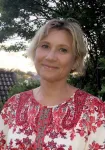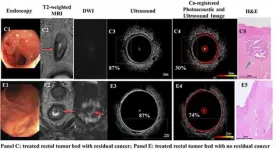Molecule attacks coronavirus in a novel way
Active ingredient inhibits infection with so-called pseudoviruses in the test tube, as shown by study at the University of Bonn
2021-03-26
(Press-News.org) Scientists at the University of Bonn and the caesar research center have isolated a molecule that might open new avenues in the fight against SARS coronavirus 2. The active ingredient binds to the spike protein that the virus uses to dock to the cells it infects. This prevents them from entering the respective cell, at least in the case of model viruses. It appears to do this by using a different mechanism than previously known inhibitors. The researchers therefore suspect that it may also help against viral mutations. The study will be published in the journal Angewandte Chemie but is already available online.
The novel active ingredient is a so-called aptamer. These are short chains of DNA, the chemical compound that also makes up chromosomes. DNA chains like to attach themselves to other molecules; one might call them sticky. In chromosomes, DNA is therefore present as two parallel strands whose sticky sides face each other and that coil around each other like two twisted threads.
Aptamers, on the other hand, are single-stranded. This allows them to form bonds with molecules to which conventional DNA would not normally bind and to influence their function. This makes them interesting for research into active ingredients, especially since it is now very easy to produce huge libraries of different aptamers. Some of these libraries contain millions of times more potential active ingredients than there are people living on Earth. "We used such a library to isolate aptamers that can attach to the spike protein of SARS coronavirus 2," explains Prof. Dr. Günter Mayer of the LIMES Institute (the acronym stands for "Life and Medical Sciences") at the University of Bonn.
Spike is essential for the infection
The spike protein is essential for the virus: It uses it to dock onto the cells it attacks. In the process, the protein binds to a molecule on the surface of its victims called ACE2, which effectively locks into the spike protein, much like a ski boot in a ski binding. The virus then fuses with the cell and reprograms it to produce numerous new viruses. "The vast majority of antibodies we know today prevent docking," Mayer explains. "They attach to the part of the spike protein responsible for recognizing ACE2, which is the receptor binding domain, or RBD."
The now isolated aptamer with the abbreviation SP6 also binds to the spike protein, but at a different site. "SP6 does not prevent viruses from docking to target cells," explains Prof. Dr. Michael Famulok of the LIMES Institute, who also works at the caesar research center in Bonn. "Nevertheless, it reduces the level of cell infection by the virus; we do not yet know which mechanism is responsible for this." The researchers did not use real coronaviruses in their experiments, but so-called pseudoviruses. These carry the spike protein on their surface; however, they cannot cause disease. "We now need to see if our results are confirmed in real viruses," Famulok therefore emphasizes.
New Achilles heel of coronavirus?
If so, in the medium term the work could for instance result in a kind of nasal spray that protects against coronavirus infection for a few hours. The necessary studies will certainly take months to complete. Irrespective of this, however, the results may help to better understand the mechanisms involved in infection. This is all the more important because the existing active ingredients mainly target the receptor domain. In the so-called "British mutation", this domain is altered so that it binds more strongly to ACE2. "The more such mutations accumulate, the greater the risk that the available drugs and vaccines will no longer work," stresses Günter Mayer. "Our study may draw attention to an alternative Achilles' heel of the virus."
The results are also evidence of successful cooperation: Mayer and his postdoctoral researcher Dr. Anna Maria Weber were primarily responsible for characterizing the aptamer. Prof. Famulok's group at the caesar research center was responsible for conducting the pseudovirus experiments, which were led by his colleague Dr. Anton Schmitz. Famulok and Mayer are members of the Transdisciplinary Research Areas "Life & Health" and "Building Blocks of Matter and Fundamental Interactions". Mayer also heads the Center of Aptamer Research and Development (CARD) at the University of Bonn.
INFORMATION:
Funding:
The study was funded by the German Federal Ministry of Education and Research (BMBF) and the German Research Foundation (DFG).
Publication: Schmitz, A., Weber, A., Bayin, M., Breuers, S., Fieberg, V., Famulok, M., and Mayer, G. (2021), A SARS?CoV?2 spike binding DNA aptamer that inhibits pseudovirus infection by an RBD independent mechanism. Angew. Chem. Int. Ed. Accepted Author Manuscript.
https://doi.org/10.1002/anie.202100316
Contact:
Prof. Dr. Günter Mayer
LIMES-Institut der Universität Bonn
Tel. +49-228-732935
E-mail: gmayer@uni-bonn.de
Prof. Dr. Michael Famulok
LIMES-Institut der Universität Bonn
Forschungszentrum caesar
Tel. +49-228-735661
E-mail: m.famulok@uni-bonn.de
[Attachments] See images for this press release:

ELSE PRESS RELEASES FROM THIS DATE:
2021-03-26
Researchers have demonstrated that stretching shape-memory polymers embedded with clusters of gold nanoparticles alters their plasmon-coupling, giving rise to desirable optical properties. One potential application for the material is a sensor that relies on optical properties to track an object or environment's thermal history.
At issue is a stretchable polymer embedded with gold nanospheres. If the material is heated and stretched, followed by cooling to room temperature, the material will hold its stretched shape indefinitely. Once reheated to 120 degrees Celsius, the material returns to its original shape.
But what's really interesting is that the gold nanospheres are not perfectly dispersed in the polymer. ...
2021-03-26
A recent study published in JCI found that a neutrophil's endoplasmic reticulum, the organelle that normally makes proteins in the cell, becomes stressed in the autoimmune disorder lupus. This stress activates a molecule called IRE1α, which appears to play a critical role in lupus pathogenesis in mice.
A multidisciplinary research group at the University of Michigan, spanning microbiology, dermatology and rheumatology, discovered that IRE1α orchestrates the release of neutrophil extracellular traps, or NETs, from lupus neutrophils. NETs are sticky, spider web-like structures that cause inflammation when released at the wrong time or in the ...
2021-03-26
Research has found that obesity and mental disorders such as depression and anxiety seem to often go hand in hand. Researchers at Baylor College of Medicine and collaborating institutions are providing new insights into this association by identifying and characterizing a novel neural circuit that mediates the reciprocal control of feeding and psychological states in mouse models.
Similar to human patients, mice that consumed a high-fat diet not only became obese, but also anxious and depressed, a condition mediated by a defective brain circuit. When the researchers genetically ...
2021-03-26
Reactive oxygen species (ROS) cause oxidative stress at the cellular level. Research shows that this way, amongst others, they inhibit the germination capacity of plants, produce cytotoxins or exert toxic effects on aquatic invertebrates. Environmentally persistent free radicals (EPFR) are potential precursors of ROS because they can react with water to form these radical species. "Therefore, EPFR are associated with harmful effects on the ecosystem and human health," explains Gabriel Sigmund, the lead investigator of the study.
"Our study shows that these environmentally persistent free radicals ...
2021-03-26
Colorectal cancer risk does not rise after bariatric surgery, a study from the University of Gothenburg shows. This finding is important for patients with obesity, and their healthcare professionals, when deciding upon such an operation.
Obesity is a known risk factor for several types of cancer, including colorectal cancer (affecting the colon or rectum). It is already established that bariatric surgery leads to a decrease in overall cancer risk in patients with obesity.
However, some studies on colorectal cancer have shown an elevated cancer risk after bariatric surgery, while others have reported a risk reduction. ...
2021-03-26
The immune systems of all vertebrates contain specialized cells, called T cells, that play a fundamental role in protecting against fungal, bacterial, parasitic and viral infections. T cells use 'molecular sensors' called T cell receptors (TCRs) on their surface that can detect and eliminate the invading pathogens. For most of the past four decades, it was considered that there were only two T cell lineages, αβ and γδ T cells, characterized by their cell surface expressed αβ and γδ TCRs, respectively.
In a paper published today in Science, an international team of scientists at the University of New Mexico (US), Monash University (Australia), and the US National Institutes of Health, has defined a novel T cell lineage, called γμ ...
2021-03-26
Renewable energy demand and consumption is at an all-time high in the United States.
Shrub willow - a quick-growing woody crop - can be an excellent source of renewable bioenergy. The crop is harvested and turned into wood chips, which can be used for heat, mulch, animal bedding, biochar, and biofuel.
In a new study, researchers grew shrub willow on a semi-commercial scale to better understand the nuances of this bioenergy crop. The research was published in Agronomy Journal, a publication of the American Society of Agronomy.
"We learned and developed key know-hows that we can transfer to industry partners interested in this crop," says Armen Kemanian. Kemanian is a member of the American Society of Agronomy and is the ...
2021-03-26
Rectal cancer, along with colon cancer, is the third-most common type of cancer in the United States, and treatment and surgery greatly affect the quality of life of patients. A multi-disciplinary team at Washington University in St. Louis has developed and tested an innovative imaging technique that is able to differentiate between rectal tissues with residual cancers and those without tumors after chemotherapy and radiation, which could one day help to avoid unnecessary surgeries in some patients who have achieved complete tumor destruction after chemoradiation.
Quing Zhu, PhD, professor of biomedical engineering at the McKelvey School of Engineering, and members of her lab developed ...
2021-03-26
The Institute for Quality and Efficiency in Health Care (IQWiG) revised its methods paper and published the German original version "Allgemeine Methoden 6.0" (General Methods 6.0) on http://www.iqwig.de in November 2020. This document is the basis for the scientific work of the Institute and its external experts as well as for the collaboration with its contracting agencies, the Federal Joint Committee (G-BA) and Federal Ministry of Health (BMG). The English translation is now available on http://www.iqwig.de/en/about-us/methods/methods-paper/.
New features include statements on the investigation of the relationship between volume of services and quality, a section on different treatment periods in studies, and a more concrete approach to the assessment of clinical relevance.
In ...
2021-03-26
Scientists have developed a method to use lasers to control the movement of nanodiamonds with fluorescent centers.
Scientists have long been working on improving their ability to use lasers to move small objects without actually touching them. This method of 'optical trapping and manipulation' is already utilized in optics, biological sciences and chemistry. But objects become much more difficult to control once they grow to nanoscale size.
Now, a team of scientists including Hokkaido University's Keiji Sasaki and Osaka Prefecture University ...
LAST 30 PRESS RELEASES:
[Press-News.org] Molecule attacks coronavirus in a novel way
Active ingredient inhibits infection with so-called pseudoviruses in the test tube, as shown by study at the University of Bonn




